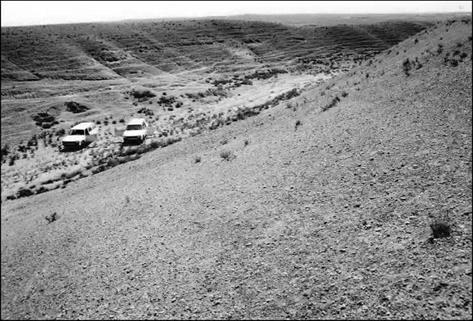The question of the long navigation canal (the nahr Daourin)
Another project in the Mari region has left us with considerable evidence of its existence. This is the canal whose traces today are called nahr Daourin, with a width of 8 to 11 m, and a reconstituted length of some 120 km. Rising at Khabur, it joins the Euphrates downstream of Mari on the left bank, cutting into the cliffs in places (Figures 2.11 and 2.12). The canal has a fairly regular slope of about 0.2 m/km, though it is somewhat flatter in its upstream portions (0.12 m/km).[66] [67]
The letter of Yaqqim-Addu, from which we have cited extracts earlier, mentions the existence of a canal issuing from Khabur at Saggaratum, at the beginning of the IInd millennium BC. This canal irrigates the Mari district on the left bank of the Euphrates, and is very likely the nahr Daourin. It was undoubtedly used for irrigation in particular given the context of the last years of Mari. But navigation was clearly the canal’s primary purpose, as evidenced by its large cross section and length, and the fact that in
|
Figure 2.12 The nahr Daourin at one of the points in its course where it is deeply entrenched into the plateau on the left bank. (Photo: French archaeological mission of Tell Hariri – Mari (Syria) |
places it is excavated into the high banks of the flood plain. It is entirely possible that the project is closely related to the very founding of Mari in the IIIrd millennium BC. Indeed, it was from this period on that bulk material, such as the charcoal necessary for metallurgy, had to be brought down to Mari from upper Khabur. It is much easier to imagine the empty boats being hauled back upstream on a canal then on the irregular course of a large river. This hypothesis would explain the particular site on which Mari was founded – on the right bank on a road that leads to Syria, but near the downstream end of the canal. Suprum, where the canal bends toward the river on the left bank a little to the north of Mari, could well be the port where merchandise was transferred between the Euphrates and the canal. In connection with this navigation canal, there would have had to be a weir on the Khabur upstream at Saggaratum, to maintain the water level during low flow. But there are no longer any remains of such a weir.
The remains of another project of this type, including a weir across the river and a [68]
lateral canal, have been found on the Euphrates somewhat further upstream. This is the
canal of Semiramis.







Leave a reply